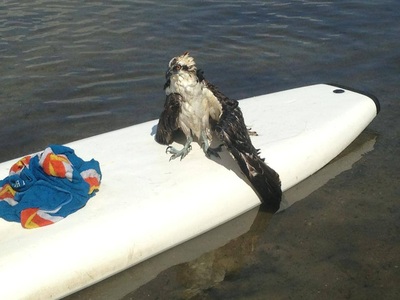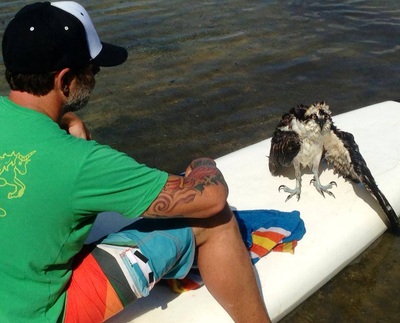|
We found and rescued an osprey yesterday with its wing wrapped in fishing line hanging from the mangroves. In the pics u can see the fishing line being cut off, but the bird's wing was broken. The osprey was taken to Bush Wildlife to be further treated.
1 Comment
Popular birds of the estuary Great Blue Heron The Great Blue Heron is a large wading bird in the heron family, common near the shores of open water and in wetlands over most of North America and Central America as well as the Caribbean and the Galapagos Islands. Voice The call is a harsh croak. The heron is most vocal during the breeding season, but will call occasionally at any time of the year in territorial disputes or if disturbed. Habitat The Great Blue Heron can adapt to almost any wetland habitat in its range. They may be found in numbers in fresh and saltwater marshes, mangrove, swamps, flooded meadows, lake edges, or shorelines. They are quite adaptable and may be seen in heavily developed areas as long as they hold bodies of water bearing fish. Great Blue Herons rarely venture far from bodies of water but are occasionally seen flying over upland areas. They usually nest in trees or bushes near water's edge, often on island (which minimizes the potential for predation) or partially isolated spots. Diet The primary food for Great Blue Heron is small fish, though it is also known to opportunistically feed on a wide range of shrimp, crabs, aquatic insects, rodent and other small mammals, amphibians, reptiles, and small birds. Herons locate their food by sight and usually swallow it whole. Typically, the Great Blue Heron feeds in shallow waters, usually less than 20 in deep, or at the water's edge during both the night and the day, but especially around dawn and dusk. The most commonly employed hunting technique of the species is wading slowly with its long legs through shallow water and quickly spearing fish or frogs with its long, sharp bill. Breeding This species usually breeds in colonies, in trees close to lakes or other wetlands. Although nests are often reused for many years and herons are socially monogamous within a single breeding season, individuals usually choose new mates each year. Males arrive at colonies first and settle on nests, where they court females; most males choose a different nest each year. Eggs are usually laid at 2 day intervals, incubated for around 27 days and hatch asynchronously over a period of several days. The first chick to hatch usually becomes more experienced in food handling and aggressive interactions with siblings, and so often grows more quickly than the other chicks. |
AuthorHello! Archives
April 2015
Categories
All
|
- Home
- Eco Tour Info
-
Tours
- PRIVATE BEGINNERS JUPITER PADDLE BOARDING ECO ADVENTURE TO FULLERTON ISLAND
- JUPITER ADVANCED PRIVATE PADDLE BOARDING ECO ADVENTURE TOUR
- Peanut Island Paddle Boarding Excursion Tour and Lesson
- Jupiter Sunrise Paddle Boarding Experience
- Jupiter Sunset Paddle Boarding Adventure
- Jupiter Paddle Board Rentals Sawfish Bay Park
- Jupiter Group Paddle Boarding Tour
- STAND UP & SHINE NIGHT SUP (PADDLE BOARDING) GLOW TOUR
- FULL MOON PADDLE Boarding Singer Island
- SUNSET PADDLE Boarding Singer Island, Florida MacArthur State Park
- Singer Island Paddle Boarding Eco Tour to Munyon Island - Near MacArthur State Park
- SUNRISE PADDLE Boarding Singer Island
- MacArthur State Park Private Paddle Board Tour - Singer Island, Fl Munyon Island
- Singer Island PRIVATE Paddle Boarding LESSON AND ECO TOUR
- MacArthur State Park Paddle Board Rentals Singer Island
- BOOK ONLINE NOW
- FAQ/Directions
- Photos
- About/Contact


















 RSS Feed
RSS Feed